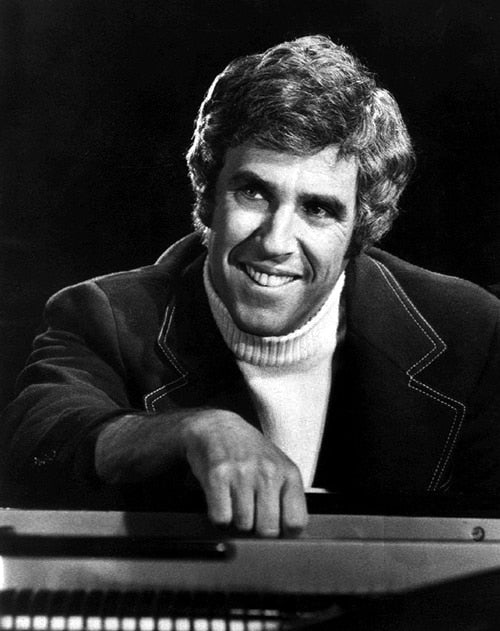Burt Bacharach is one of those composers who I’ve listened to nearly my entire life. From the age of six or seven, my mother – the adventurous listener in the house – owned a few of Bacharach’s instrumental LPs that she would play every so often. She sometimes mentioned that Dionne Warwick originally sang some of these songs, and I also remember her slipping a Bacharach/David songbook into my stack of piano books. This was much to the chagrin of my elderly piano teacher, who was the lover of schmaltzy Rodgers and Hammerstein show tunes as opposed to these newfangled composers.
I would get a couple of Bacharach’s instrumental albums over the years as gifts, but it wouldn’t be until a couple of decades later that I would buy albums or compilations containing Bacharach’s songs. The major catalyst was Rhino’s three-CD box set of Bacharach’s tunes, performed by those who made them famous. That set, The Look of Love: The Burt Bacharach Collection, was the real turning point for me, especially with its accompanying booklet that lived up to Rhino’s reputation for being comprehensive and informative. It was a crash course in the timeline of Bacharach’s career, the many artists who covered his tunes, and the history behind them all.
This is the first installment in an ongoing series, covering different eras or specific artists in each issue. Hopefully you’ll find a few hidden gems that you were unaware of, or be whisked back to the 1960s and 1970s with tunes you may not have heard in years. Burt Bacharach wrote prodigiously and is still working to this day at the sprightly young age of 93. Yet his most recognized and celebrated body of work is his long collaboration with lyricist Hal David, much of which we will cover in the series.
The Early Years
In addition to his fruitful partnership with Hal David, Bacharach would occasionally work with other lyricists such as Bob Hilliard or Hal David’s brother, Mack David. There are some gems among these early tunes, many with an unmistakable Bacharach flavor to the melody and arrangement. A student of Darius Milhaud, Bacharach took his legendary instructor’s advice: “Never be ashamed to write something that people can whistle.” Ever a perfectionist, Bacharach’s arrangements and studio session conducting were notoriously meticulous and demanding. That sophistication we find on the Dionne Warwick recordings was honed over time, and the foundation was built on earlier songs like these.
An early success for the Bacharach/David songwriting team was a 1957 release, “The Story of My Life,” by country music legend Marty Robbins, who took it to the top of the Country and Western chart. Apparently he took Milhaud’s aforementioned advice literally with this recording.
The following tune from 1958 was featured over the opening credits of the Steve McQueen film The Blob, penned by Bacharach with Hal’s brother Mack David. The Five Blobs were a studio group assembled by session leader Bernie Knee for the sole purpose of recording this song. A novelty hit at best.
In 1961, Gene McDaniels had a Number 3 hit with “A Hundred Pounds of Clay,” and followed that up two singles later with the Number 5 hit “Tower of Strength,” which Bacharach wrote with Bob Hilliard. Bacharach was dismayed that the producer of the track sped up the tempo, one of the reasons he would later have an iron grip on the entire recording process. McDaniels would later find success as a songwriter himself, penning the Number One hit “Feel Like Makin’ Love” for Roberta Flack.
Another Bacharach/Hilliard tune, “Any Day Now (My Wild Beautiful Bird),” was recorded by, and specifically written for, Chuck Jackson in 1962. When Bacharach got wind that label-mate Tommy Hunt was recording an “unauthorized” version, he was insistent to Scepter Records’ owner Florence Greenberg that Jackson record the tune, or he would discard it.
When Jerry Butler recorded “Make It Easy On Yourself” in 1962 for release on Vee-Jay Records, it marked a turning point for Bacharach. Long frustrated by the sound of his compositions in the hands of others, Butler and A&R man Calvin Carter told him, “You get the musicians, you conduct, you make the record.” From that point on, Bacharach would increasingly conduct his own studio sessions, when possible, to build up his works in the studio, and even went so far as to fuss over different pressings on later single releases, to ensure they met his exacting standards.
Jay and the Americans’ recording, “Look In My Eyes Maria” was originally tucked away on the B-side of the group’s “Come Dance With Me” single in 1963. This was produced by Lieber and Stoller, who produced a few early records Bacharach had composed music for.
Lou Johnson was one of the unfortunate vocalists to cover Bacharach/David tunes. Unfortunate in that despite his talent for covering Bacharach’s difficult compositions, most of what he recorded never became a hit, yet would later become a hit at the hands of Scepter Records, and Dionne Warwick in particular. Warwick was a fan of Johnson’s and covered some of his songs, making them hits; in fact, Johnson was sometimes called “the male Dionne Warwick” during those years. This was his first recording of Bacharach/David’s songs, only making it to Number 74 on the charts in 1963.
Gene Pitney would record a Bacharach/David song in tandem with the film The Man Who Shot Liberty Valance (the song itself was not used in the film), but the 1963 mini-story tune “Twenty Four Hours from Tulsa” was cinematic all on its own. Hal David had begun writing down short stories in a notebook, which helped organize the lyric writing for his story songs. This one is in the form of a “Dear Jane” letter.
In the next part of the series, we will explore Bacharach and David teaming up with a third partner who would define their unique brand of sophisticated soul throughout the 1960s.



